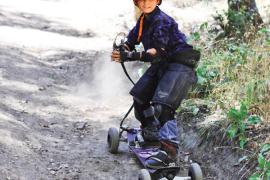Camp operates as a business, when we all know it is more. In order to focus on what matters at camp, it is crucial that camp operations run without friction. That means adopting the best business practices possible, which will allow you to focus on serving campers and staff in a way that promotes your camp's mission.
Paradoxically, one of the key components of a camp's business involves the successful implementation of technology. Most camps endeavor to implement a tech-free environment in an effort to teach 21st-century skills such as caring and teamwork. Paul Tough's newest book, Helping Children Succeed (2016), emphasizes creating environments that encourage children to learn grit and self-control, but your camp can't create this environment if you don't have a system in place to do this efficiently.
Focusing on the technology behind your operation during the nonsummer months can greatly improve the effectiveness of your program and let you focus on what really matters during camp. Fortunately, with very little investment, you can choose to use tech tools that are easy to use, inexpensive, and evergreen. Easy-to-use tools are crucial because they encourage widespread adoption across your organization. There is simply too much to do to implement technology that requires extensive training, and team members will reject a new tool that is too complex. Inexpensive is critical because, well, your budget says so. "Evergreen" means the technology will not be outdated in a few months. These tools have been and will be around for many years. While they may not be truly evergreen — best practices will certainly change in ten years — you won't find these businesses changing in the short run.
Google Calendar
The short version: Google Calendar offers a single source of truth for what's happening and when at your organization. Eliminate confusion by setting up and sharing calendars with all of your full-time team and maybe even some key seasonal players.
The long version: Google Calendar is the ultimate organizational tool for your camp. If you do not currently have a central calendar at camp, you often don't know where your co-workers are or when particular groups are checking in and out. Then there's the routine maintenance you need to remember to schedule. Having a decentralized calendaring system is the worst approach a camp can take, because it means some of the finer details will be missed, no matter how hard you try to ensure they are not.
To get started with Google Calendar, all you need is an account. Even if your camp uses Outlook or another e-mail service, you can still use Google Calendar. Simply sign up using your e-mail address with Google. Once you have logged in, you can create different calendars that you can turn on and off for different views, then share those calendars with relevant staff by assigning permissions. Is your head spinning yet?
Here's an example: Imagine that you need to ensure your ropes course inspections are completed monthly. Set up your Maintenance Calendar first. Then share it with any relevant staff, including your ropes course manager. (Choose which staff need read-only as well as edit permissions.) Next, create an event that recurs every month. If you want, you can also set up e-mail notifications within the event to remind you at any frequency, perhaps one week before and one day before. Now your calendar will remind you monthly that your ropes course inspection needs to be completed.
You might also wish to create separate calendars for Groups, Summer Camp Sessions, Marketing, Meetings, etc., but I intentionally chose the Maintenance Calendar (and ropes course maintenance, in particular) for this example. Sometimes it's okay to miss scheduled deadlines, especially during a busy season, but missing a ropes course inspection deadline is not okay. Monthly inspections are best practice within the industry, and it is crucial to keep our campers safe. So, while Google Calendar makes you more organized, it can also make you safer by ensuring you are committed to completing important safety inspections each month.
Dropbox for Business
The short version: Dropbox for Business is the only tool on this list that costs money, but it's worth it. Store and share documents that you can access from anywhere, including on your mobile devices. Never say, "It's on my computer in the office" again.
The long version: Despite the investment of about $15 per user per month, I'd argue that Dropbox for Business is the most indispensable tool on this list. One of the hardest things to do is create a file structure that is accessible to all team members in a way that works for everyone at all times. Dropbox for Business is the only tool I have ever found that comes close to making this a reality. As a camp director, you need to be able to access your files anywhere, anytime, and on any device at a moment's notice, and Dropbox actually makes it possible to do so.
My former supervisor set up an ingenious filing system within Dropbox based on ACA-accreditation standards, and I recommend it to any camp. Your first level of organization within your team folder should be based on the standards categories: Finance, Food Service, Program Design, Risk Management, Site and Facilities, Trips and Travel, and Transportation. This basic hierarchy not only gives you a good starting point for organization, but it allows you to collect the information you need when it comes to re-accreditation more easily. It saves you time when you really need it most.
Dropbox for Business was crucial during staff training. I saved each year's activities and all supporting documents in a folder sorted by year, so I could refer to the previous year to get some of the essentials as well as ensure I was not repeating anything. Additionally, when there was staff turnover, I could refer to former staff members' notes and files in Dropbox. Crucially, when I was about to run a session and realized I had forgotten to print something, I pulled the document up on my phone via the Dropbox app. I found that to be one of my biggest achievements as a camp director: No more did I leave staff sitting and waiting while I ran around trying to quickly print another document.
Google Forms
The short version: Get feedback from staff and parents fast. Google Forms is versatile, totally free, and can be used for everything from notifying you when supplies are low to getting e-mails from parents to their campers.
The long version: While SurveyMonkey is my favorite tool for parent surveys, Google Forms is free and has vastly improved since its creation. Creating or refining your parent survey is a project you can do today after reading this article. Follow these instructions to create your first Google Form (Note: Google is constantly innovating, so some of these steps may change.):
- Go to google.com/drive to log in (or create your account). You must have a Google Drive account to create a Google Form — if you haven't done it before, it can be a little confusing. Like Google Calendar, you can create an 1-800-231-5468 [email protected] account for free.
- Once you have logged in, click on the big, red NEW button on the left side of the page, then choose more; then choose Google Forms.
- Once you create a new form, you will see the options to create a short answer, paragraph, multiple choice, checkbox, dropdown, linear scale, or multiple choice grid type of question.
- Create, save, and share your survey in the top right of the page.
Google Forms is a flexible way to get any kind of information. Besides parent surveys, you can also use it to get information when supplies are getting low or to facilitate one-way parent e-mails. Simply set up a new form and share the link with your staff or parents. Parents can submit to the form, then each day you can print all of the responses individually. Google Forms allows you to print individual responses at the click of a button, which makes it a hugely powerful tool at absolutely no cost to your camp.
WordPress
The short version: If you're paying a professional inordinate amounts of money for a website, you're doing it wrong. Anyone can manage a WordPress website, so you can make minor tweaks anytime you need to.
The long version: WordPress was initially developed as a blogging platform, but now it is a powerful website editor tool. It is almost free, but most camps will want to pay for a .com or .org web address, which you can do directly and seamlessly via WordPress. (There are other options for more features that cost money too, but a camp with limited resources that is just getting started with updating its website may want to just stick with the free version.)
Too many camps and other businesses pay large amounts of money for web design, with the designer sometimes requiring an ongoing maintenance fee. If you have someone who is even remotely tech savvy and has a good eye for graphic design, I recommend that person try to make a WordPress website for your team for free. If you don't have anyone like that, you can find and pay a WordPress designer a few hundred dollars to design your website. Once designed, you can take over the management of it. There's no reason for you to send minor edits to your web designer.
Evernote
The short version: Evernote is your digital notebook and to-do list. You can use it to write and organize everything from staff meeting agendas to new ideas to combinations for locks that you always forget.
The long version: Evernote, like Dropbox, has the enviable feature of syncing across all of your devices. Unfortunately, Evernote recently announced that users of the free version can only sync between two devices (i.e. your computer and your phone, but not your tablet), but that won't likely get in the way of what you're using it for. If you find you like it that much, it is probably worth paying for the upgrade.
Think of Evernote as your personal notebook. More than any other app, it can replace the physical notebook in your pocket. It allows you to organize different notebooks by category as well as search all of your notes simultaneously. So if you used it to take notes at a conference where you learned lots of great nature activities, you can later search the app for the word "nature," to find those activities and share them with your nature staff member on a whim.
I find Evernote most useful in two areas: creating staff meeting agendas and saving important but occasionally needed information. For staff meeting agendas, items come from a myriad of sources: parent e-mails, conversations with staff members, and bursts of inspiration in the middle of the night. Evernote let me seamlessly create staff meeting agendas anywhere and anytime. Additionally, I could search information such as the "combination to a faraway maintenance shed" or the "contact information for roadkill removal" — real entries in my Evernote app that I needed rarely but urgently when the occasion arose.
Achieve Your Mission
By no means is this list comprehensive, but it is manageable. Getting to work on implementing each of these new technologies now means that you'll have better systems in place before your staff arrive. Perhaps you can get started today by downloading the Evernote app or creating a Google Form. Achieve your mission this summer and focus on what really matters by implementing these tools while you still have time.
Reference
Tough, P. (2016). Helping children succeed: What works and why. New York, NY: Houghton Mifflin Harcourt Publishing.
Rich Rinaldi is a former camp director who runs Lights Out (lightsoutatcamp.com), which helps camp professionals work smarter, not harder. He has degrees from Georgetown University in operations management and Chaminade University in nonprofit management. Reach him at [email protected].


